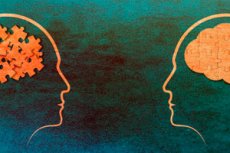New approach shows promise for treating frontotemporal dementia in preclinical trials
最近審查:14.06.2024

Frontotemporal dementia is an incurable brain disease that causes memory loss, speech problems and personality changes. In 5-12% of cases, the disease is triggered by a decrease in progranulin levels. The lack of this protein leads to disturbances in the breakdown of proteins, which causes the accumulation of insoluble toxic proteins. This, in turn, leads to brain inflammation, neuronal death and significant functional impairment of the central nervous system.
Frontotemporal dementia is inherited in 40% of cases: carriers of the corresponding genetic mutation inevitably develop this disease. Researchers from the LMU Faculty of Medicine and the German Center for Neurodegenerative Diseases (DZNE), in close collaboration with San Francisco-based Denali Therapeutics, have developed a new therapeutic approach to replace the missing protein in the brain. They published their results in the journal Science Translational Medicine.
Therapeutic approach
“We inserted the progranulin gene into the genome of the virus,” explains Dr. Anja Kapel, senior researcher at the LMU Biomedical Center and one of the lead authors of the paper. The team then injected the modified viruses into the bloodstream of the mouse models. "The virus targets liver cells, which begin to produce progranulin in large quantities and release it into the blood."
The approach thus avoids directly injecting viruses into the brain, which carries the risk of serious side effects.
To make this peripheral approach work, the researchers used a trick to overcome the blood-brain barrier, which normally blocks the exchange of biomolecules between the blood and the brain. A special “brain shuttle” developed by Denali Therapeutics allows substances to be efficiently transported across this barrier.
Significant reduction in symptoms in a mouse model
“After a single injection of the virus, we tested whether symptoms were reduced,” says Professor Dominique Paquette from the Institute of Stroke and Dementia Research (ISD), another lead author and member of the SyNergy Cluster of Excellence. It was found that abnormalities in protein degradation, accumulation of insoluble toxic proteins, brain inflammation, movement disorders and neuronal death were significantly reduced. "The next step was to investigate whether this approach could be translated to humans using stem cell models." There was also a significant reduction in symptoms of the disease. In summary, the researchers demonstrated that forms of frontotemporal dementia based on partial loss of progranulin can be treated in preclinical trials using replacement therapy.
The importance of interdisciplinary collaboration
Such comprehensive multidisciplinary research is only possible in a team. "I am pleased that our SyNergy Cluster of Excellence provides us with unique capabilities in this regard. At the same time, this study highlights the importance of strengthening our collaboration with leading biotechnology companies so that we can translate our research into clinical practice as quickly as possible for the benefit of patients." says Professor Christian Haass from the LMU Biomedical Center, one of the leading researchers and SyNergy speaker.

